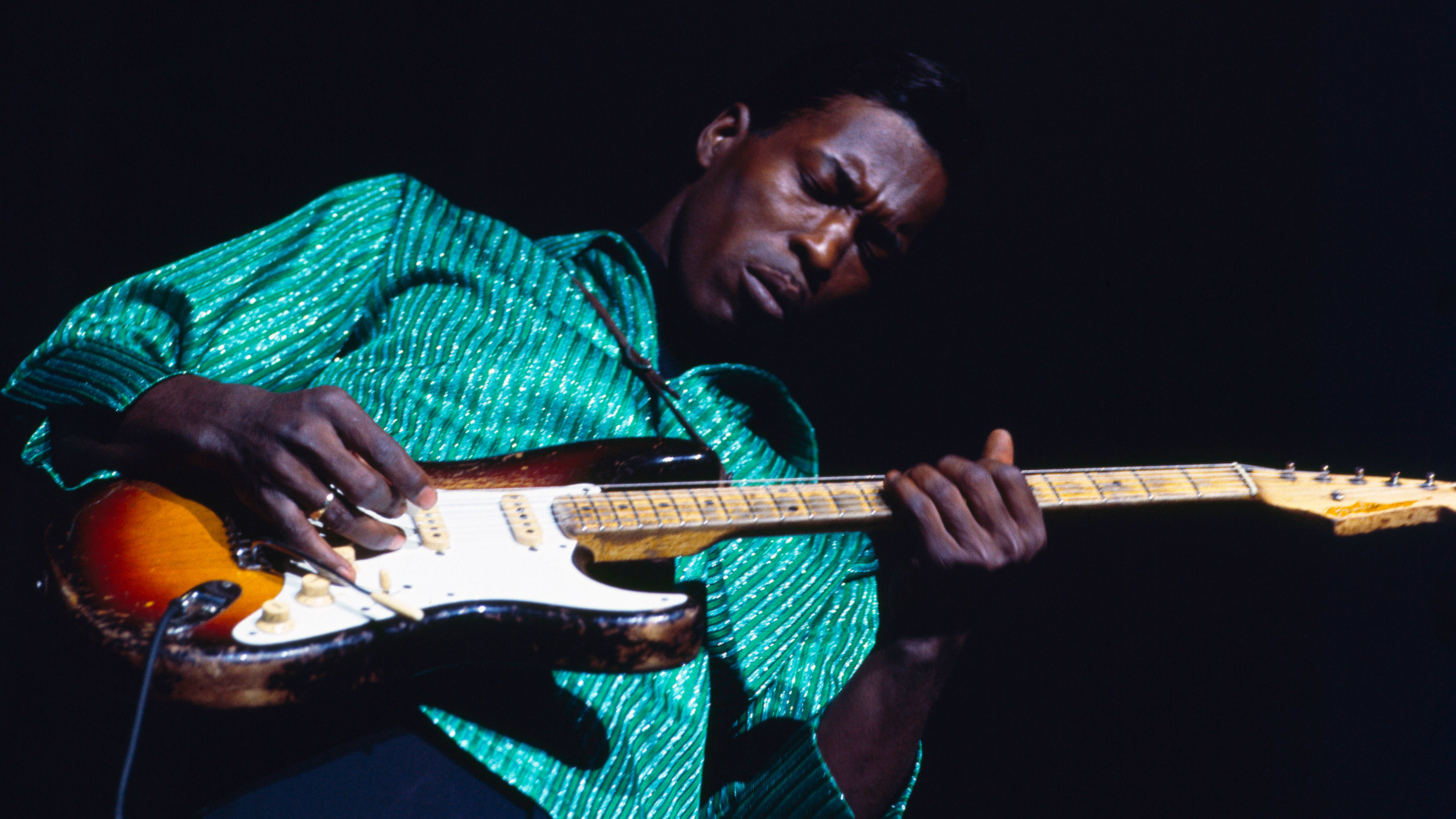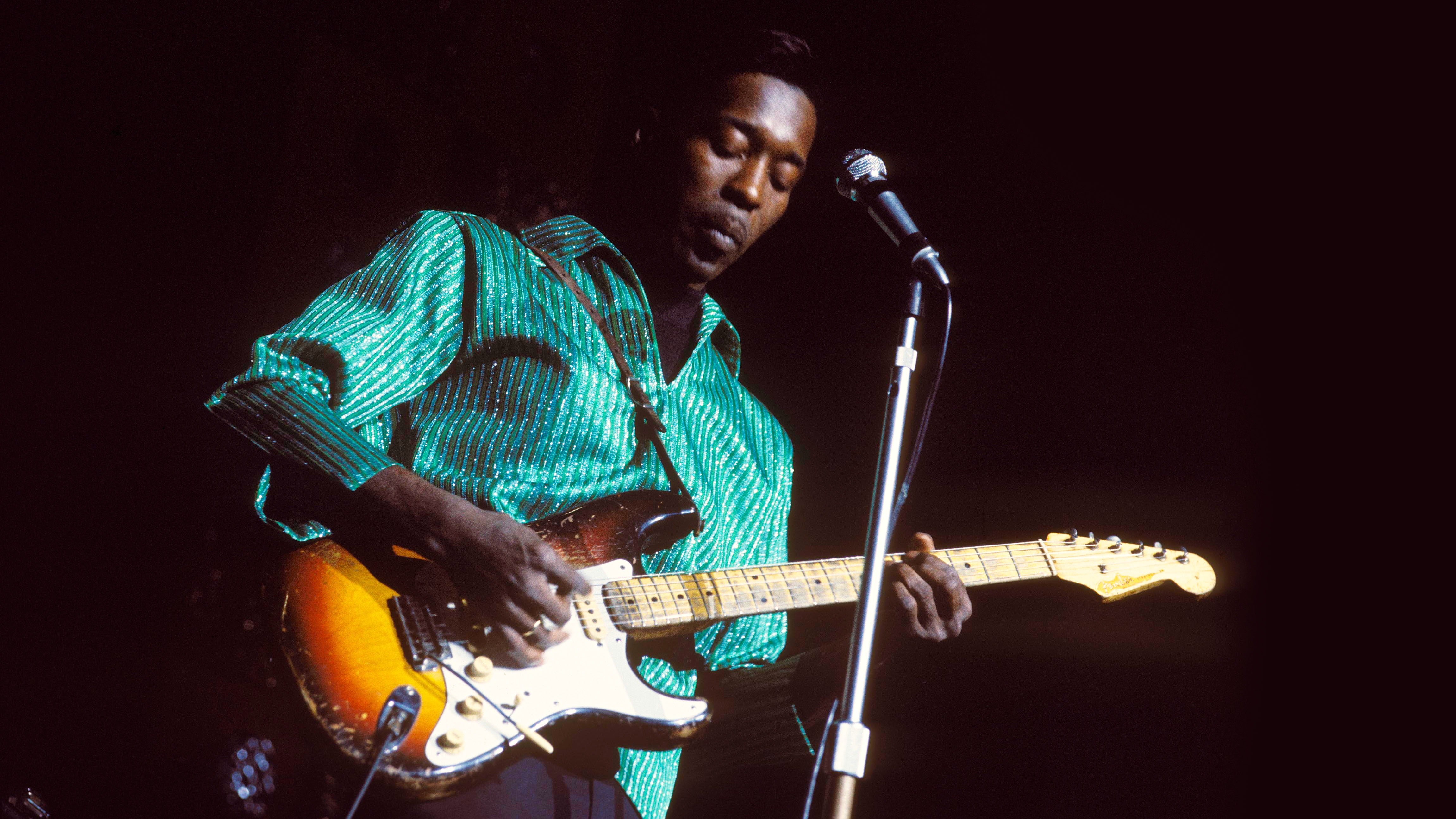
As cross-cultural high points go in post-war austerity Britain, the American Folk Blues Festival tours that started in 1962 took some beating. Seemingly out of nowhere, iconic blues artists of the age such as Muddy Waters, Howlin’ Wolf, Willie Dixon, John Lee Hooker and Sonny Boy Williamson fetched up on these shores to enlighten and dazzle.
The media loved it. In 1964, Granada Television released a special documentary, watched by 12 million people, and filmed on the platform at Wilbraham Road railway station in suburban Whalley Range, Manchester. Muddy Waters performed, sporting a trilby and Telecaster, and surrounded by a large group of fans. Another highlight of the event was Sister Rosetta Tharpe. After stepping gracefully along the puddle-strewn platform, Tharpe strapped her beloved white ‘61 Les Paul SG Custom over her long fur coat and launched into the first number of her set.
“Didn’t it rain children? Didn’t it rain?” she sang in her powerful, low tones as the audience roared its approval. Singing a gospel tale about Noah’s flood to the sodden audience on a suburban Manchester branch line was an irony not lost on the audience. Tharpe’s sheer power and electricity bowled the crowd over. “She staggered everybody,” recalled one fan.
The American Folk Blues Festival became an annual event and on Thursday, 25 February, 1965, 200 miles due south, a similar epiphany took place at the Marquee club, 90 Wardour Street in Soho, London. On the bill that night was Buddy Guy, a guitarist who had made a name for himself playing with blues icons such as Muddy Waters. Howlin’ Wolf and Sonny Boy Williamson.
Buddy Guy was a pioneer of the use of distortion and feedback in the blues and his playing was unlike anyone else around. His style was dynamic, fearless and utterly enthralling. He would search for the highest squalling notes, all delivered with impeccable feel and emotion.
As he stepped out on stage at the Marquee that evening, the audience included guitar luminaries of the British blues explosion, such as Eric Clapton. He was all too familiar with Buddy’s talent having heard him on records by Muddy Waters, Little Walter and Willie Dixon. "Guy’s playing just stood out in the mix, because of the originality and vitality of his playing, recalled Clapton in 2005, as he and BB King inducted Buddy Guy into the Rock and Roll Hall of Fame.
Clapton went on to describe the impact of Buddy’s performance at the Marquee back in 1965. “In the flesh, he was earth shattering,” recalled Clapton. “His style on every level was fantastic. Doing all the things we would later come to associate with Jimi Hendrix, playing with his teeth, his feet, and behind his head. He brought the house crashing down.”
Clapton recalled that Buddy gave a “thundering performance, delivering the blues with finesse and passion in a way I had never heard before”. It also set Clapton to thinking that a trio was a pretty good line-up for a band.

He was for me what Elvis probably was for most other people
Eric Clapton
“All in all, everything about that night was deeply profound for me," Clapton added. "The blues was clearly alive and well and it looked good too, for as well as being the real thing, musically Buddy was a star. His suit, his hair, his moves, his sunburst Strat, everything was sharp and perfect. He was for me what Elvis probably was for most other people.”
Like all the iconic blues musicians, George ‘Buddy’ Guy came up the hard way. Born in 1936 in Lettsworth, Louisiana, he was one of five children in a family of sharecroppers and began learning the guitar by playing a two-string diddley bow that he made. He later gravitated to a Harmony acoustic and in the mid-1950s was playing with bands in Baton Rouge.
In September 1957, he moved to Chicago and soon earned a reputation as a uniquely gifted player, falling under the electric crossover influence of Muddy Waters.
Buddy signed to legendary blues label Chess Records in 1958 but his career there never really flourished. The label’s founder Leonard Chess allegedly described Buddy’s style as “just making noise”, according to a piece by Greg Prato in 2012 in Rolling Stone and the label attempted instead to promote him performing R&B ballads, jazz instrumentals, soul and novelty dance tunes.
But Buddy was also working as a session guitarist with Muddy Waters, Howlin’ Wolf, Little Walter and Sonny Boy Williamson among many others. And he was soon in demand.
Buddy’s first electric guitar was a Les Paul Goldtop, but this was stolen in 1957 from a club in Chicago, as he recalled in an interview with Reverb you can watch above. When it came to getting a replacement instrument, it wasn’t a Les Paul he went for, but a Stratocaster. It was an unorthodox choice for the blues. At that point Strats were more associated with country music. But Guy knew within seconds of trying the Strat that this was the guitar for him.
“Man, that guitar: you could hit a note on that guitar and hold it until next week,” he recalled about his first Strat, in the Reverb interview. “People look at you and ask, ‘Is that you still playing?’ Because it still looks like it’s holding that sound too long.”
This was the guitar he was playing at the Marquee club in 1965 and for Clapton and others in the audience such as Jeff Beck, his choice of a Strat was a revelation. That gig was still fresh in Clapton’s mind in 2013, when Guitar Center presented Clapton with the Fender Custom Eric Clapton ‘Brownie’ tribute Stratocaster.
They said they didn’t know a Strat could do that
“I heard Buddy Guy on an album called Folk Festival of the Blues where he was the new kid on the block playing with Muddy and Howling Wolf and they’re all singing and he just launched into this solo that killed everybody dead. And then I went to see him play and I thought, ‘This is the sound’. And funnily enough, I saw [Steve] Winwood using [a Strat], just about the time he was about to leave Spencer Davis. And Hendrix.”
Guy reflected to Reverb on he influenced players like Eric Clapton and Jeff Beck to use Strats. “They said they didn’t know a Strat could do that,” Guy added. “Eric and them laugh now every time I get in the room, saying, ‘Man, we didn’t know a Strat could play the blues until we saw how you did it’.”
Clapton sought out Strats with maple necks but most of the models in the UK at the time had rosewood necks.
“It wasn’t until I went through the States on tour that I started picking them up in pawn shops for a song. I’d buy four or five at a time.”
I was bringing it up to Eric and Jimmy. ‘Have you heard this stuff?'
Jeff Beck
For Jeff Beck, the impact of seeing Guy at the Marquee in 1965 had a similarly profound effect.
“Buddy Guy just hit the spot for me,” Beck told Don Wilcock, author of the biography Damn Right I Got The Blues. “It’s his youthful vigour, sort of manic stuff and comedy. He has a lot of very exquisite timing and is delightfully out of key sometimes. That’s what I find so charming. It’s just a hair sharp. It wouldn’t be right, had it been dead on the note. From there on, I was like a junkie. I would go around looking for other people to share the same stuff. I was bringing it up to Eric and Jimmy – ‘Have you heard this stuff!?'”
Jimmy Page too was bowled over by Buddy Guy’s playing. "Jeff Beck and myself, we were still probably teenagers when we heard Buddy Guy,” recalled Page on The Late Show with David Letterman in December 2012. “I remember being with Jeff and playing the vinyl which was called Folk Festival Of The Blues, where Buddy Guy is really young on it and he’s playing with Muddy Waters, Sonny Boy Williamson, Howlin’ Wolf, etc, and he sings two songs on it and just the whole delivery, and the passion, and the drama… the guitar is just out of this world.”
Despite his fearsome reputation as a player, until 1967 Buddy Guy was having to work as a tow truck driver in the daytime while playing clubs at night. But by the end of the decade, his fortunes were changing. In March 1969, he was invited to play at the so-called Supershow, in Staines, Middlesex, alongside Clapton, Led Zeppelin, Jack Bruce, Stephen Stills, Buddy Miles, Glen Campbell and others.
In 1972, he established the Checkerboard Lounge with LC Thurman, a blues club in Chicago’s South Side. He left the partnership in 1985 and in 1989 opened Buddy Guy’s Legends club, a venue that is still thriving today.
Guy’s career received a significant boost during the blues boom of the late eighties and early nineties, and in 1990 and 1991, Clapton invited him to be part of 24 Nights, a live album compiled from 42 concerts at London’ Royal Albert Hall. Guy went on to sign a deal with Silvertone Records and recorded his album Damn Right I’ve Got the Blues, in 1991. This was his break into the mainstream market and from that point on, Buddy Guy’s stature on the world stage was elevated.
In 2006, he appeared onstage with the Rolling Stones at the Beacon Theatre in New York, a performance so effortlessly impressive that at the end of the song, Keith Richards, handed over his black Guild Starfire to Guy as a tribute and gift.
Buddy Guy is now the last, living American blues legend. When Clapton and BB King inducted him into the Rock and Roll Hall Of Fame in 2005, their induction speeches were both reverential and heartfelt. When Buddy Guy himself stepped onto the podium to accept the honour, he was clearly moved.
“Look at this,” grinned Guy as he looked over to his left where BB King and Eric Clapton were standing. “To be standing here and [having to] pick up a guitar and get between these two guys and play… man, you’ve got to be me to know how I feel tonight. This is no small task.”
As he ended his acceptance speech, he left the assembled artist and music industry dignitaries in the audience with one last parting thought. “If you don’t think you got the blues,” he grinned, “just keep livin’.”







